by Craig Brelsford
Founder, shanghaibirding.com

On 17 Sept. at Pudong’s Cape Nanhui, I achieved a personal first: photos of an unmistakable Sakhalin Leaf Warbler Phylloscopus borealoides. As expected, the photos show a leaf warbler whose plumage and bare parts are virtually indistinguishable from those of Pale-legged Leaf Warbler P. tenellipes. Coupled, however, as they are with sound-recordings of the same individual, ensuring the ID, the photos constitute a rare visual record of Sakhalin Leaf Warbler in Shanghai.
The leaf warbler I found was easily identifiable as a member of the Pale-Sak species pair. It had strikingly pale pink tarsi, an olive-brown crown contrasting with olive-green mantle and wings, a long and creamy supercilium, and faint wing bars on the median and greater coverts.
The bird, which was in Microforest 1 (30.923889, 121.971639), behaved in a way typical of the Pale-Saks I have observed in the Cape Nanhui microforests, eight tiny woods that dot the coastline of the cape. Rarely venturing more than 2 m off the ground, the leaf warbler favored low branches and vines for browsing and sturdy low branches for perching. It pumped its tail steadily, called spontaneously, and upon hearing playback of its own call moved in to investigate the source.
Without recording the call of the leaf warbler (call as well as song being a diagnostic separator of Sakhalin and Pale-legged), would I have been able to get an ID? Almost certainly not, said leaf-warbler expert Phil Round:
“I am a bit less sanguine on finding means (other than call frequency or song) to separate all [Pale-Saks]. Even in the hand, it is by no means clear. We can pick out long-winged male Sakhalin, and short-winged female Pale-legged. But there is more overlap than previously realized, and most are in between. There don’t appear to be any 100% consistent wing-formula differences, and plumage and bare-part features, while somewhat indicative, are again less than 100% reliable—especially under field conditions” (Round, in litt., 2016; emphasis mine).
The most convenient separator of Pale-Sak is song, the cricket-like trill of Pale-legged being easily separable from the metallic whistle of Sakhalin. As Shanghai lies outside the breeding range of both species, Pale-Sak songs are not often heard in Earth’s Greatest City. I have heard Sakhalin sing only once, on 5 May 2016 at Shanghai’s Zhongshan Park (Brelsford, May 2016). The song of Pale-legged I have heard at various locations in Shanghai as well as on its breeding grounds in Heilongjiang (Brelsford, June 2016).
Although not as readily distinguishable as the songs, the tink calls of Pale-Sak differ markedly and consistently and are a reliable basis for an ID (Yap et al. 2014; Round et al. 2016; Weprincew et al. 1989). Yap et al. say the call of Pale-legged is of a “consistently higher frequency” than the call of Sakhalin. The calls that I have recorded of the two species show a difference in frequency of about 1 kHz, very much in line with others’ findings (Brelsford, August 2017; Brelsford, September 2017).
For birders unaccustomed to Pale-Sak calls, the difference may be hard to detect, especially at windy Cape Nanhui. A sound-recorder (which may be a smartphone) will pick up the difference, and an audio spectrogram will show it graphically. Solid, indisputable ticks, in some cases life ticks, await enterprising birders who sound-record.
In recent months, my work with sound-recordings has helped give Shanghai birders a clearer picture not only of Sakhalin Leaf Warbler but also of Kamchatka Leaf Warbler Phylloscopus examinandus, like Sakhalin a poorly known passage migrant through Shanghai (Brelsford, June 2017). In the case of Pale-Sak in Shanghai, a picture is emerging of overlapping migratory pathways. This finding comports with the findings of Yap et al. at Beidaihe, a thousand kilometers to the north. After analyzing calls obtained at Beidaihe of both Pale-legged and Sakhalin, Yap hypothesizes that in coastal Hebei “the migratory pathways of the two sister species may largely overlap” (2014).
How extensive is the Pale-Sak migratory overlap in Shanghai? How many of the Pale-Saks that we find in Shanghai each spring and autumn are Pale-legged, and how many are Sakhalin? Is there a peak passage time in Shanghai for each species, and if so, when is it?
Answers to these questions are currently unknown, but they are probably knowable, and it is very much possible for the citizen-scientists of Shanghai to be the producers of that knowledge. We need only to change our habits. When it comes to identifying lookalike species such as Pale-legged and Sakhalin Leaf Warbler, birders need to understand that photos do nothing to cut through the muddle. Only sound-recordings lead to indisputable records and a clearer picture of the species in Shanghai.
SOUND-RECORDINGS
The sound-recordings and audio spectrograms below show clearly the difference in frequency between the calls of Sakhalin and Pale-legged Leaf Warbler.
Sakhalin Leaf Warbler Phylloscopus borealoides, Microforest 1 (30.923889, 121.971639), Cape Nanhui, Shanghai, 17 Sept., by Craig Brelsford (1:03; 12.2 MB)
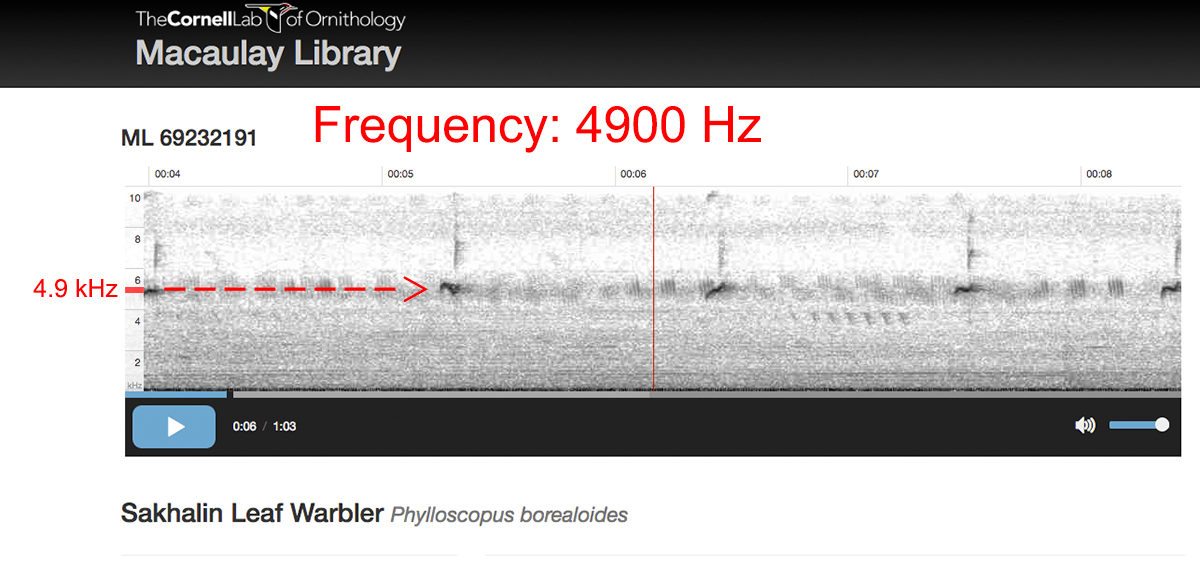
Pale-legged Leaf Warbler P. tenellipes, Magic Parking Lot (30.884889, 121.968222), Cape Nanhui, 4 Sept., by Craig Brelsford (0:19; 3.7 MB)
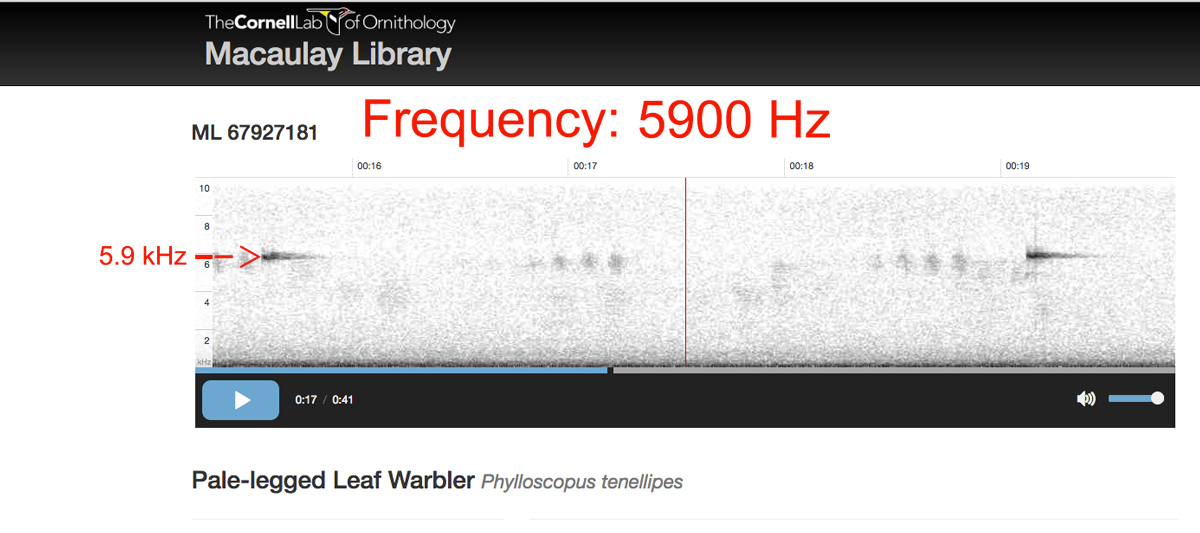
PHOTOS
Here are photos of the Sakhalin Leaf Warbler of 17 Sept. The bird below is the same individual whose voice I sound-recorded.
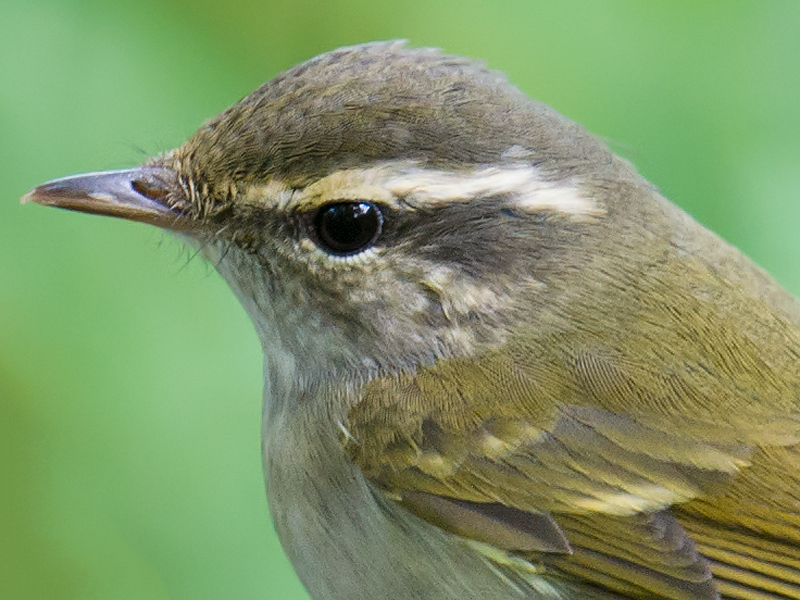
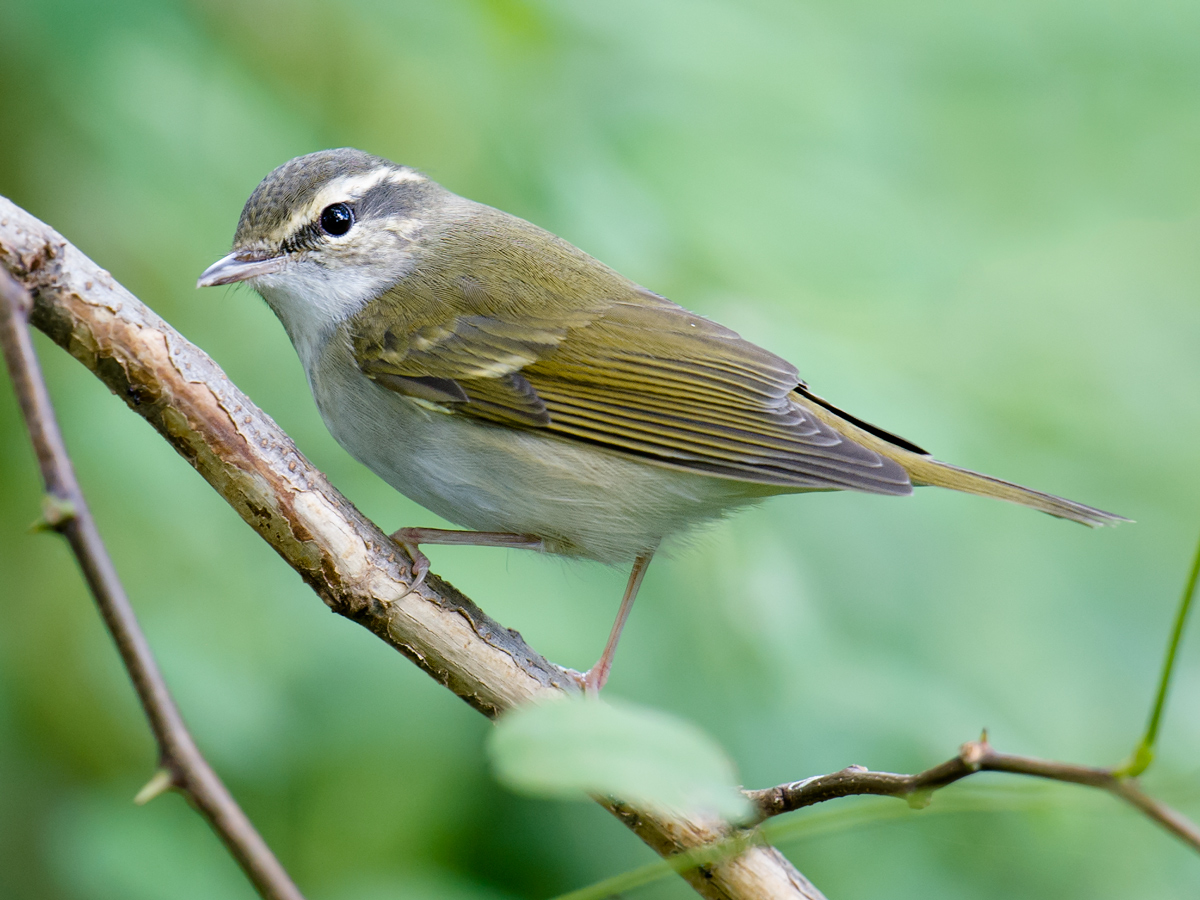
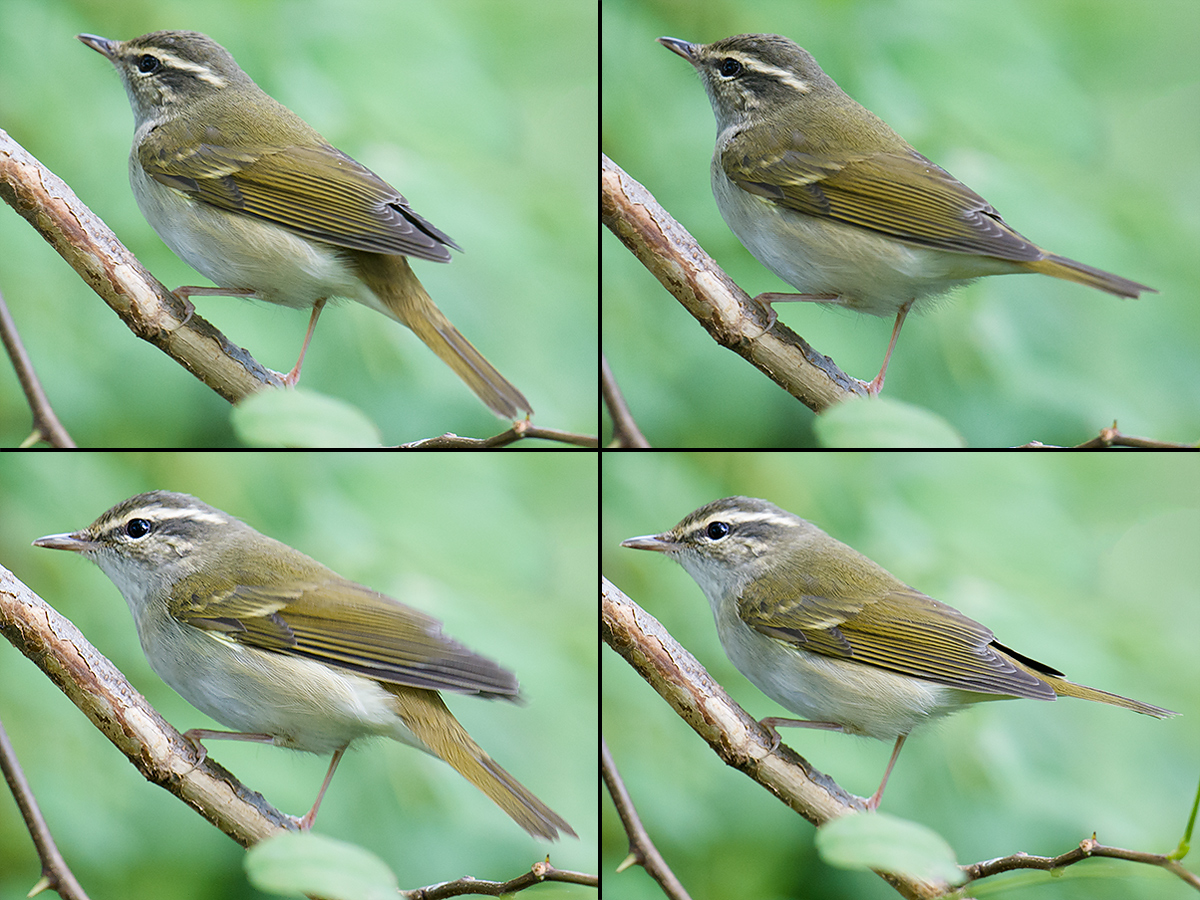
REFERENCES
Brelsford, Craig. Sakhalin & Pale-legged Leaf Warbler, Singing Together. Post to shanghaibirding.com published 5 May 2016 (accessed: 16 Apr 2025).
———. Kamchatka Leaf Warbler in Shanghai. Post to shanghaibirding.com published 6 June 2017 (accessed: 16 Apr 2025).
———. Separating Pale-legged & Sakhalin Leaf Warbler on Call. Post to shanghaibirding.com published 31 Aug. 2017 (accessed: 16 Apr 2025).
———. Pale-Sak Calls: An Addendum. Post to shanghaibirding.com published 10 Sept. 2017 (accessed: 16 Apr 2025).
———. Boli County, Heilongjiang, May-June 2016: Introduction. Post to shanghaibirding.com published 15 June 2016 (accessed: 16 Apr 2025).
Round, Philip D. E-mail message to Craig Brelsford, 18 Oct. 2016. Round’s e-mail message was originally cited in the shanghaibirding.com post “Pale-legged Leaf Warbler & the Shanghai Big 5,” published 26 Sept. 2016 (accessed: 16 Apr 2025).
Round, Philip D., Pierce, Andrew J., Saitoh, Takema, & Shigeta, Yoshimitsu. 2016. Addition of Kamchatka Leaf Warbler Phylloscopus examinandus and Sakhalin Leaf Warbler P. borealoides to Thailand’s Avifauna. Bulletin of the Japan Bird Banding Association 28: 9–21. Available here for download (708 KB) through shanghaibirding.com (accessed: 16 Apr 2025).
Weprincew, B. N., Leonowitsch, W. W. & Netschajew, W. A. 1989. Zur Lebensweise von Phylloscopus borealoides Portenko und Phylloscopus tenellipes Swinhoe. Mitteilungen aus dem Zoologischen Museum in Berlin 65 (Suppl.): 71–80. (German only)
Yap, F., Yong, D. L., Low, B., Cros, E., Foley, C., Lim, K. K. & Rheindt, F. E. 2014. First wintering record of the Sakhalin Leaf Warbler in South East Asia, with notes on vocalisations. BirdingASIA 21: 76–81.
Featured image: Sakhalin Leaf Warbler Phylloscopus borealoides, Cape Nanhui, Shanghai, 17 Sept. Craig Brelsford photographed and sound-recorded this individual, getting a rare record of the poorly known species in Earth’s Greatest City.

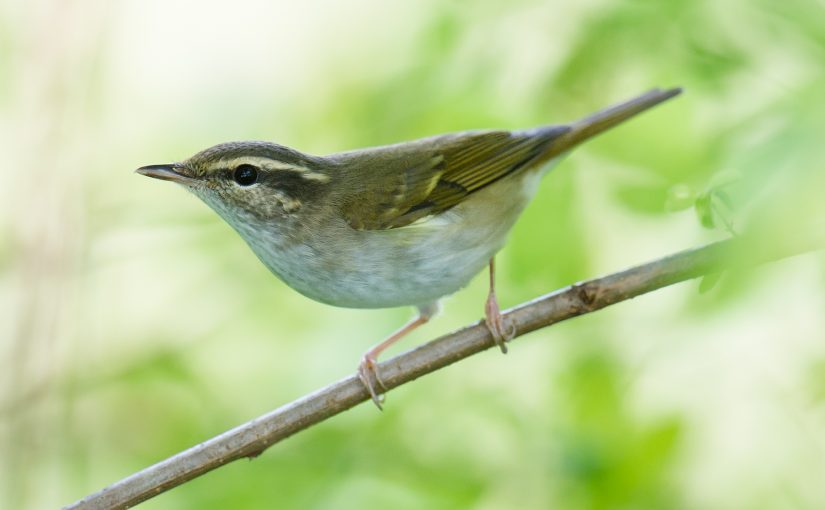
Thank you, Craig, for this excellent blog post! Before my trip to Shanghai, I made sure to catch up on the local hotspots and relevant posts on shanghaibirding.com so as to better prepare myself. Having read the above blog, I knew that if I was going to run into any Pale-legged or Sakhalin warblers, I would need to make a simple recording of call notes (using the built-in Voice Memos app in my iPhone) to make the ID. When I ran into some calling warblers near the Magic Parking Lot, I got my phone out, recorded, and watched through my binoculars. When I got back from my birding session (50 species half-day, not bad!), I uploaded the recordings to eBird and analyzed the frequency in the sonogram that eBird automatically provides. To my surprise, the call notes were all at about the 4900 Hz mark, clearly indicating Sakhalin rather than Pale-legged! That’s a lifer bird for me and a great scientific record provided by an ordinary dude who likes to get out and bird. Recording bird calls and songs, especially of those look-alike Old World warblers, is a great way to confidently rack up your life list while providing good scientific data and learning to become a better birder all at the same time. I highly recommend it!
Here’s the checklist with the recordings: http://ebird.org/ebird/view/checklist/S39450566
Alex, you are the poster child for proper Sakhalin Leaf Warbler documentation! Congratulations! You have followed the plan to a T and with little effort and expense attained valuable records of a poorly known East Asian species. As you point out, you used nothing more than the iPhone in your pocket to get your sound-recordings of Sakhalin Leaf Warbler. This is the way to work!
Your sound-recordings of calling Sakhalin Leaf Warbler broaden our basis of knowledge about that species in Shanghai. I sound-recorded Sakhalin this past 4 Sept. and 17 Sept. 2017, and now we have your recording of 29 Sept. Just like that, we have solid evidence (as opposed to mere guesswork) of a presence of Sakhalin Leaf Warbler in Shanghai throughout the month of September! From this basis more inferences can be made. For example, is migrating Sakhalin common in Earth’s Greatest City? Perhaps so, perhaps no, but a sustained presence of the species during the heart of fall migration season certainly does not point to it being uncommon.
Hi, Craig! Found a Pale-legged Leaf Warbler in my local park this morning. Rare here in Beijing. Had a very useful brush-up on Pale-Sak ID by reading this post on shanghaibirding.com!
Hi Jan-Erik, I’m happy that you found Beijing rarity Pale-legged Leaf Warbler in your Chinese hometown, and I’m even happier that my posts help you nail the ID.
I read this article before, and then when the migrating season of leaf warblers, like Pale-Sak, Arctic-Japanese-Kamchatka which shall be IDed by sound records, comes again in Apr and May at Cape Nanhui, Shanghai, I recently read this post again word by word. I always find Craig’s posts and shanghaibirding.com useful and helpful. Thank you, Craig.